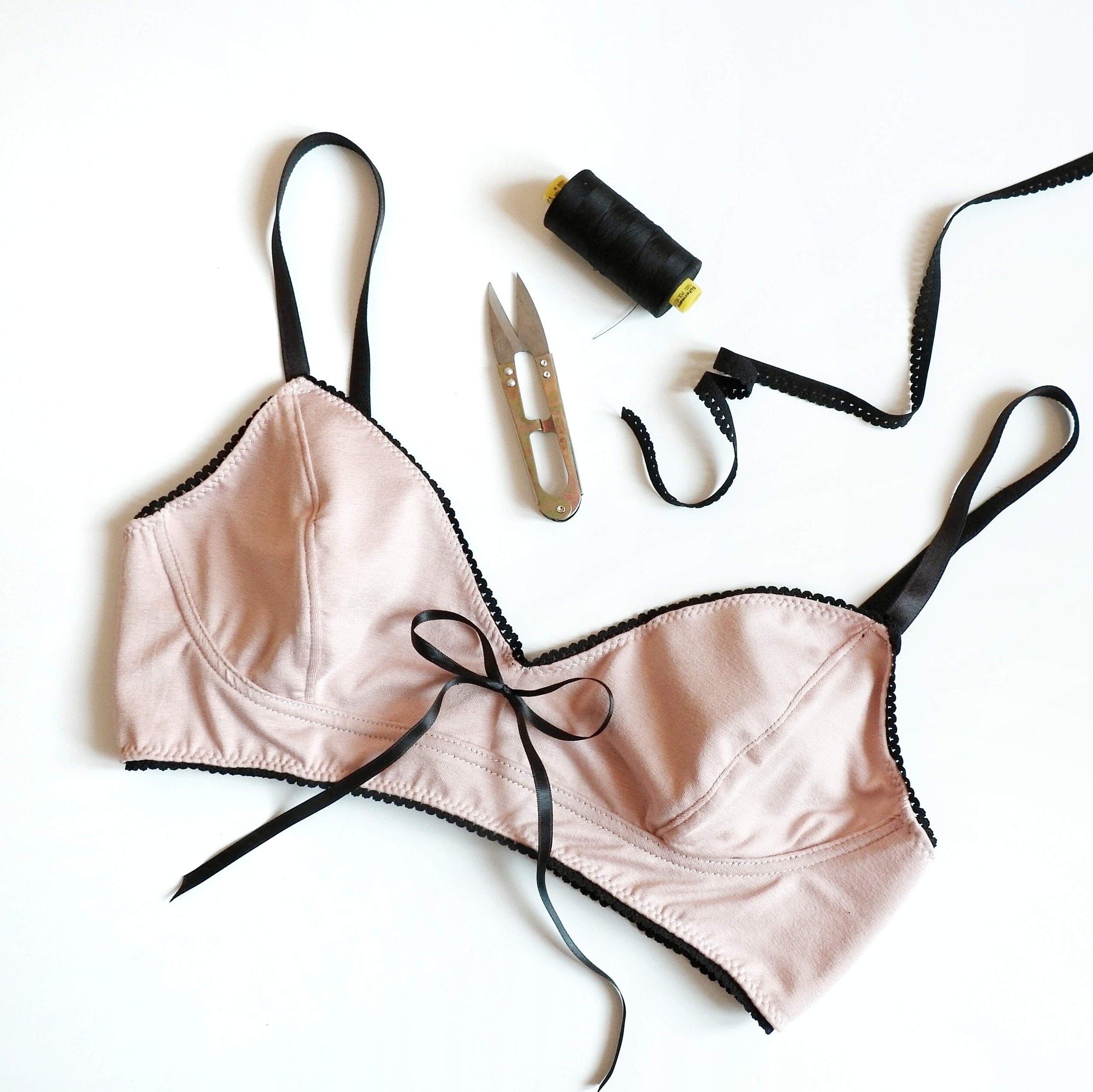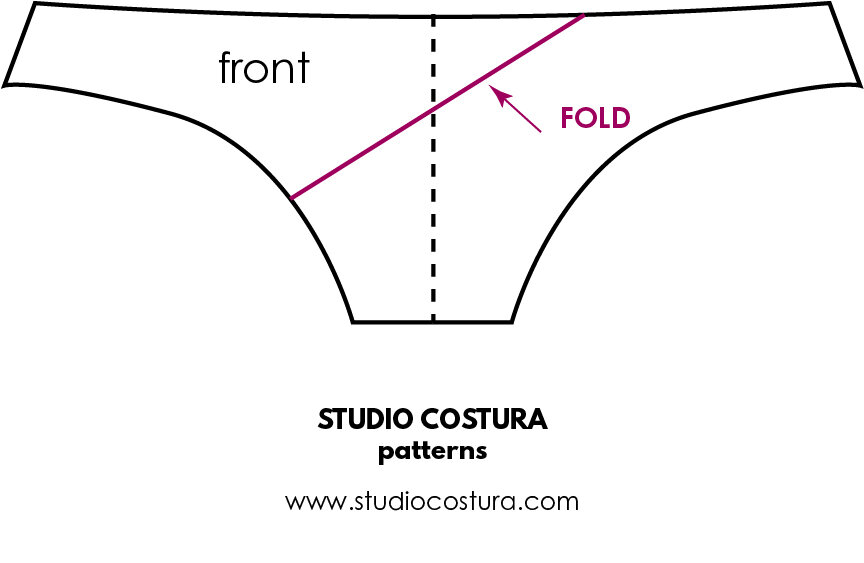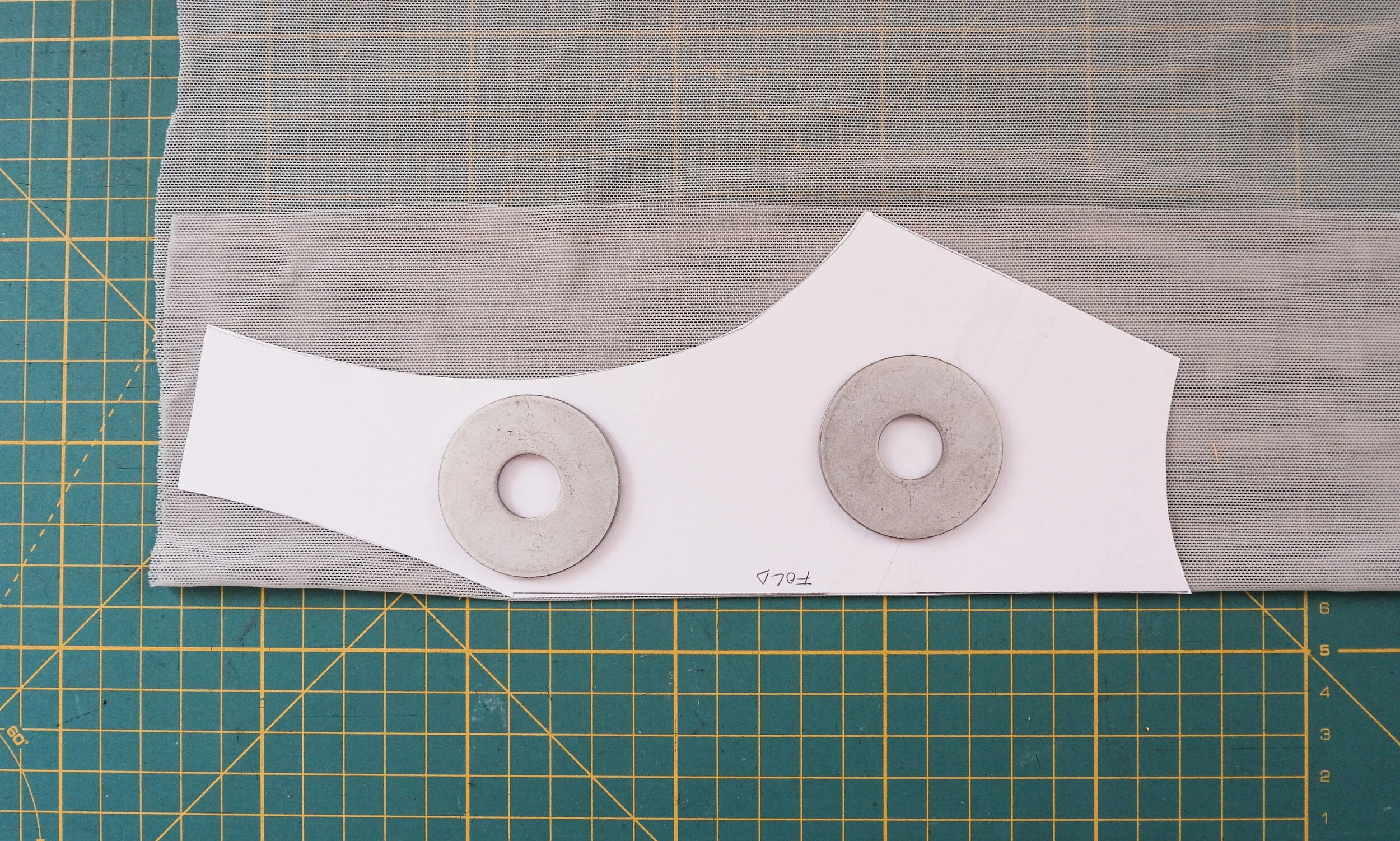Today I’m bringing you another post for the Mara bralette sewalong: how to sew this bralette with knit fabrics (you can see all the sewalong posts here). As you’ve probably seen, all my patterns have lace samples on the product page but this doesn’t mean you can’t use knits to make all of them! It’s a very easy adjustment and I’ll show you a couple of different ways you can do it.
Hoy os traigo otro post para el coseconmigo de bralette Mara: cómo coser este bralette con telas de punto (puedes ver todos los posts del coseconmigo aquí). Cómo ya habéis visto, en todas las fotos de portada de mis patrones sale lencería hecha con encaje pero eso no significa que no se pueden hacer con telas de punto! Es un cambio muy fácil y os enseño un par de maneras de cómo hacerlo.
First of all I wanted to highlight these Mara bralettes made by a talented seamstress @birdy_sew_obsessed over at Instagram because she’s done just that: beautiful bralettes made with knit fabric (and she has pretty ones with lace too of course!). If you’re not following Bird already you should because she’s posting amazing content and showing so many sewing tips and tricks both on her feed and Instagram stories. I would highly suggest that you’d look up the highlighted stories she has published about making her Mara bralette makes, you can see fit pictures and a lot of other cool sewing process images.
Primero quería enseñar estos bralettes Mara hechos por la costurera excelente @birdy_sew_obsessed en Instagram porque ella ha hecho justo eso: bonitos bralettes de punto (también ha hecho cosas muy bonitas con encaje, claro!). Si no sigues a Birdy todavía deberías hacerlo porque en su Instagram tanto en su feed como en las historias está siempre compartiendo procesos y técnicas de costura muy interesantes. Os recomiendo mucho ver su historia destacada de Mara bralette donde podéis ver cómo le queda puesto y también allí hay un montón de imágenes interesantes de cómo ha estado cosiendolo.
Making this pattern with knits instead of lace is very easy, you don’t need to do almost any pattern alterations and you can use a lot of cute prints or combine solids to create contrast like I did in this sample. The main difference with the lace version is that you need to add elastic to the neckline where the scalloped lace edge is. I’ll show you how to do that with a regular picot elastic.
To use picot elastic that needs to be folded under for the second pass of zig zag you need to add seam allowance for the inner cup neckline (the straight diagonal edge). As in the original version you use lace, there’s no seam allowance, but you need that to sew on the elastic. Just add the extra seam allowance to that side only (the rest will be as is) depending on the width of your elastic. If you’re using a 5 mm elastic, add 5 mm, if you’re using a 10 mm elastic, add 10 mm.
Coser este patrón con telas de punto en vez de encaje es muy sencillo, casi no tienes que hacer nada diferente y puedes usar estampados monos o combinar lisos para contrastes como he hecho yo en este tutorial. La diferencia con la versión de encaje es que necesitas poner el elástico en el escote donde normalmente está la puntilla. Voy a enseñar cómo se hace con elástico de lencería.
Para usar elástico de lencería que hay que doblarse debajo de sí mismo cuando se cose la segunda pasada de zig-zag necesitas margen de costura en el escote de la copa interior (la línea recta en diagonal). Ya que en la versión original se usa encaje, este borde no tiene margen incluido, pero lo necesitas para coser el elástico. Simplemente añade el margen según el ancho de elástico que usas. Si usas un elástico de 5 mm, añade los 5 mm, si usas uno de 10 mm, añade los 10 mm.
Cut the pattern pieces for the cups from knit fabric and lining using the new inner cup piece and the usual outer cup piece. I’m using a viscose knit for the exterior layer and power mesh for the lining. You could also use the same knit fabric for the lining but I prefer mesh as the result is less bulkier but the choice is yours of course. Then first sew together the cup pieces and the front seam as described in the instructions (your knit pieces are now the lace pieces) to have all the seams enclosed.
Corta las piezas de las copas de tela de punto y del forro usando la nueva pieza de copa interior y la pieza normal de copa exterior. Estoy usando un punto de viscosa y de forro un tul elástico. También puedes usar la misma tela de punto para el forro pero yo prefiero tul porque así hay menos grosor de telas en conjunto pero puedes optar por lo que quieras por supuesto. Primero une las piezas de copas y el centro delantero tal como está explicado en las instrucciones del patrón (tus piezas de punto son ahora las piezas de encaje) para tener las costuras recubiertas.
Now you’ll attach the elastic to the neckline. I’ve chosen to show you the method of sewing the elastic in one piece on top of both of the cups instead of sewing the elastic first on one cup, then on the other cup and then sewing the front seam together, because this way you’ll have a neater finish on the inside. Just start sewing on one of the cup pieces on the right side and when you reach the center front, go and pivot the elastic and keep on sewing until you reach the other end. This is the first pass of zig zag.
Ahora coses el elástico en el escote. He elegido el método de coser el elástico en una misma pieza encima de todo el escote en vez de coserlo primero en una copa y luego en la otra por separado, porque de esta manera tienes el acabado más limpio por dentro. Simplemente empieza a coser desde un extremo y cuando llegas al centro delantero gira el elástico y sigue cosiendo hasta el otro extremo. Esta es la primera pasada de zig-zag.
Now turn your elastic onto the wrong side of the bralette and sew the second pass of zig zag pulling the fabric slightly when you pivot to have a neat finish. And that’s it! You can now continue sewing the bralette as described in the instructions.
Ahora doble el elástico al revés del bralette y cose la segunda pasada tirando ligeramente del elástico cuando llegas al punto de giro para que quede bonito por fuera. Y ya está! Puedes seguir cosiendo el bralette tal como explicado en las instrucciones.
I really like the result as it’s very different from the lace version and everyone likes different things so you can really get a lot out of the same pattern.
Here’s also a little tip when sewing with contrast elastics. To get neat results you should obviously change the upper and lower threads according to which side you’re currently sewing. When sewing with contrast colors (for example black and pink here) some machines might not have the tension adjusted correctly and you can see little dots of the upper thread showing on the reverse side of your sewing...this might be very disturbing when you’re sewing on the elastics as you’re sewing the second pass of the zig zag on the wrong side of the bralette and the upper thread can show on the right side of your work and ruin it all. What I usually do to avoid that is to sew the second pass of zig zag directly on the right side of the project. It’s more difficult to keep the elastic in place but with some experience you can do it and that way you’ll be sure that the pretty stitching will be on the right side of the work and if any upper thread will show on the other side, at least it will be the inside of your project.
Me gusta mucho el resultado ya que es muy diferente de la versión con encaje y como cada una tiene sus gustos, puedes usar un mismo patrón para muchas variaciones.
Aquí va también un truco si usas elásticos en colores que contrastan con tu tela. Para tener un acabado bonito deberías obviamente cambiar la bobina de arriba y la canilla según qué lado estés cosiendo para tener los colores bien. Cuando coses con colores que contrastan (por ejemplo aquí rosa y negro) algunas máquinas no consiguen tener una tensión correcta del hilo y se puede ver unos puntitos pequeños de hilo de arriba que sale en la costura de abajo...eso puede quedar feo porque la segunda pasada de zig-zag lo haces en el revés del bralette y el hilo de contraste puede aparecer justo en el derecho de tu trabajo. Lo que yo suelo hacer para evitar esto en casos así es coser la segunda pasada de zig-zag desde el lado derecho directamente. Es un poco más complicado mantener el elástico bien ya que no lo ves pero con algo de experiencia lo puedes hacer y así estarás segura de que la puntada bonita queda en el derecho y si se ve algo de otro color abajo será en todo caso en el revés de tu proyecto.
You can also use fold over elastic (FOE) to cover the neckline. In that case you don’t need to add the seam allowance for the elastic as FOE won’t be folded under and you don’t need any extra fabric on the neckline. Again, just sew the cup pieces and the center front together and then attach FOE (you can follow this tutorial to see how to sew with fold over elastic).
También puedes usar bies elástico (FOE) para cubrir el escote. En este caso no tienes que añadir margen de costura ya que el FOE no se dobla debajo de sí mismo y no necesitas más margen en la copa interior. De nuevo, primero une las piezas de las copas y el centro delantero y después cose el FOE (puedes seguir este tutorial para coser con bies elástico).
There’s also another way to make knit bralettes: you can add a cute lace trim for the neckline! These pretty trims add a sweet touch when you combine them with knits. To do so just cut your inner cup piece of knit fabric as usual and attach the lace trim on it, then continue as if you were sewing with lace. You can see how I’ve used this trim for the Hanna bralette in this tutorial, the process is the same!
También hay otra manera para coser bralettes con punto: puedes añadir una puntilla al escote! Estas puntillas dan un toque bonito cuando se combinan con telas de punto. Para usarlas simplemente corta la pieza de copa interior de tela de punto como siempre y cose la puntilla encima de ella, sigue las instrucciones como si esta pieza fuera de encaje. Puedes ver cómo lo hice con el bralette Hanna en este tutorial, el proceso es lo mismo!
I hope you liked this Mara bralette variation! I’ve listed some knit kits both for Mara and Hanna bralettes if you want to try out something else than lace, there are all black kits and black & pink kits with the same supplies I used to make this sample. There are also FOE and narrow lace trims available at the shop if you want to experiment with some colors.
Espero que os ha gustado esta variación de bralette Mara! He subido esta semana unos kits para Mara y Hanna para hacerlos con telas de punto, tenéis kits con negor y negro y rosa como lo que usé en este tutorial. También están en la tienda muchos colores de FOE y puntillas elásticas si queréis dar un toque de color a vuestros proyectos de lencería.











































































































































